Diving Into The Bright Spots Of Last Week's Election
A closer look reveals some positive takeaways for Democrats after a heartbreaking election

It’s exactly a week out from Election Day, and we are, of course, still reeling from Kamala Harris’s loss to Donald Trump.
Like many Democrats, we’re left wondering what our fellow Americans were possibly thinking putting this liar, convicted felon, and sexual assaulter in charge of the country again, particularly as we watch his minions follow through on the deplorable things he pledged during the campaign.
We are left wondering how the most vulnerable among us will be impacted by Trump’s second-term policies without any guardrails in place.
And we are left wondering exactly when some of our Trump-supporting friends and family are going to figure out just what they’ve done. Beginning January 20, 2025—if not sooner—they’re gonna start the “find out” phase. But unfortunately, so will the entire country.
It’s important to note, however, even as we mourn Harris’s loss at the top of the ticket, that it’s not all as hopeless as some would have us believe. As we wrote on Sunday in our Week In Wins piece, Democrats did have many victories to celebrate, even if we don’t feel much like celebrating at the moment.
So today, I’m going to expand on that piece and take a bit of a deeper dive into why Tuesday actually offers some hope moving forward for Democrats.
Our weekday pieces here at The Big Picture are free for all to read but we can only do this work thanks to the support of our paid subscribers. So if you value the work we are doing, we invite you to upgrade your subscription to support our efforts!
No MAGA Mandate
Predictably, in the early morning hours Wednesday, after it was clear he would prevail in the election but before most of the votes had been counted, Trump declared he’d won “an unprecedented and powerful mandate.”
Of course, this is the same guy who declared that he won the 2020 election late into election night four years ago, which was as false then as it is today. But as we all know, Donald Trump doesn’t exist in the reality as it is; he projects the reality he wants people to believe.
So, it’s worth a look at just how laughable his claim of an “unprecedented mandate” actually is.
Donald Trump’s final Electoral College victory is 312-226.
By historical standards, that is an objectively close margin, with Trump having done just a hair better than Joe Biden in 2020 (306-232), who did a hair better than Trump in 2016 (304-227.) Should we compare Trump’s measly 312 Electoral Votes with Ronald Reagan’s 489 EVs in 1980 or 525 in 1984? Or George H W Bush’s 426 in 1988, or Bill Clinton’s 370 in 1992 or 379 in 1996? Or perhaps Trump would like to compare himself to President Obama, who won 365 EVs in 2008 and 332 in 2012? No, there’s nothing “unprecedented” about Trump’s victory.
But one need only look at Trump’s popular vote count to fully suck the air out of his boast. Yes, Donald Trump broke Republicans’ long losing streak by actually winning the popular vote for the first time in 20 years. But his popular vote margin is nothing to brag about.
As of this writing, according to CNN, Trump leads Harris by 3.2 million votes, or 50.2% to 48.1% with 95% of the votes counted. With millions of votes left to count, including in very blue parts of California, that margin will close. As of this morning, Nate Silver even suggested that when all is said and done, Trump could end up with under 50% of the vote, with a winning margin of under 1.5%.
It’s very possible.
Compare this with four years ago, when Joe Biden—whom Trump never would never have conceded had a “mandate”—won by 7 million votes and 4.4% of the vote.
As The New York Times’ Ezra Klein wisely puts it:
And as Joseph O’Neill told NY Books:
Harris lost, yes—but let’s not overegg the pudding. Trump’s margin of victory was humdrum. His final vote tally will fall millions short of the votes won by Biden in 2020. The opposition to him is huge and intense and in the right. So let’s be clear: this malicious criminal does not have the barbaric mandate he claims for himself.
Or to put it another way, mandate, my ass.
And while Trump won at the top of the ticket, make no mistake, Tuesday was an outright loss for other MAGA candidates. Just look at two of the candidates most aligned with Trump, who wore their MAGA badges proudly and sported Trump endorsements: Mark Robinson, Republican candidate for Governor in North Carolina, and Kari Lake, Republican candidate for Senate in Arizona. Both lost decisively.
In North Carolina, Robinson lost to Democratic Attorney General Josh Stein by almost 15%.
Along with Stein, North Carolina voters ushered in a new Democratic Lt. Governor, Rachel Hunt, a new Democratic Attorney General, Jeff Jackson, and Democrats even flipped a state House seat to break Republicans’ legislative supermajority, which means Governor Josh Stein will be able to veto the worst of what Republicans try to unilaterally shove down North Carolinians’ throats. That’s progress.
In Arizona, Democratic Rep. Ruben Gallego defeated MAGA election denier Kari Lake for the state’s open U.S. Senate seat by 2.5%.
That makes Gallego the first Latino U.S. Senator from Arizona and marks the fourth Democratic U.S. Senate win in the state in a row. That means that Arizona, whose voter rolls boast 300,000 more Republicans than Democrats, has Democrats serving as both U.S. Senators, Governor, Attorney General, and Secretary of State. Perhaps claims of the Democratic Party’s demise were a bit premature.
Kamala Harris’s Campaign Mattered
What both of these wins have in common, of course, is that they took place in two of the nation’s most competitive swing states, where the Harris campaign devoted the bulk of its resources. So while Harris may not have prevailed on Tuesday, it’s important to note the impact her campaign had in the states where she had the most visibility and the most robust organization.
Looking at the nationwide vote, there is no sugarcoating the reality that the electorate shifted toward Trump by around 6% relative to 2020. That is difficult to swallow and speaks to a failure of the Harris campaign to turn out the voters she needed last Tuesday. But it’s important to note that in swing states, the Harris campaign was able to keep that shift to just 3%. And while that may seem like cold comfort, it made a real difference on the margins.
In addition to Gallego, Democrats did very well in swing state U.S. Senate races, including running the table with all Democratic female candidates, including Senator Jacky Rosen in Nevada, Senator Tammy Baldwin in Wisconsin and Senator-elect Elissa Slotkin in Michigan. Ultimately, of course, with the loss of Senator Bob Casey in Pennsylvania, Democrats are poised to go into 2025 with a Senate minority of 47 seats, but imagine how much worse it would have been if there hadn’t been such a robust ground game in those states.
As Wisconsin’s Democratic Party chair Ben Wikler explained on X:
And looking at how the electorates in certain swing states leaned in 2024 relative to the nation as a whole, notice the trend in North Carolina:
This strong Democratic performance in North Carolina is going to be crucial in 2026 when Senator Thom Tillis is up for reelection (he only won by 3% in 2020) and in 2028 when Sen. Ted Budd is up. Flipping those seats is the path back for Democrats to a Senate majority by 2028. The Harris campaign laid solid groundwork for what Democrats need to do in the next midterms (think 2018 all over again!)
Similarly, look at Georgia’s 2024 partisan lean as compared to Florida’s, where the Harris campaign invested far fewer resources:
As Nate Silver notes, the strength in Georgia was largely due to growth outside of Atlanta, which this year defied the pro-Trump national trend.
So while it’s tempting to look only at the result at the top of the ticket, don’t let that obscure the important work that the Harris campaign did on the ground to help push down-ballot Democrats over the top as well as lay the groundwork for the future blueing of states that this year fell Trump’s way.
From North Carolina’s new state Rep.-elect Dante Pittman, whose flip of a red seat helps keep Republicans from wielding an ongoing legislative supermajority, to Michigan where Democrats expanded their majority on the state Supreme Court, to Pennsylvania where Democrats held onto their state House majority, the work on the ground in swing states proved decisive in race after race.
A shift of 6% toward Trump nationally is nothing to sneeze at, of course, nor is losing the U.S. Senate and failing to take back the House. But the high-profile losses Democrats suffered on Tuesday simply do not tell the whole story.
The fact that Trump succeeded where other Republicans failed is the result of millions of undervotes where voters simply left the down-ballot races blank and voted for Trump alone. That is not the sign of a fundamental shift toward the Republican Party.
Progressive Policies Keep Winning
Additionally, several progressive policy priorities were on the ballot last week, and in large part, whether in blue states or red, those policies proved exceptionally popular when voters were given the chance to directly weigh in on them.
Out of the ten states that had abortion rights protection measures on the ballot last Tuesday, the initiatives passed in six of them, including in red states like Montana and Missouri where, thanks to these results, there will now be legal pathways to challenge the current restrictive GOP abortion bans. A similar measure garnered 57% in Florida but failed to meet the 60% threshold. Abortion protection measures also passed in swing states Arizona and Nevada, as well as blue states such as New York, Maryland, and Colorado, where there will now be additional firewalls against future Republican attempts to restrict women’s freedom.
While abortion rights ballot measures were the most high-profile of the policy initiatives up for a vote last Tuesday, two red states offered voters the chance to raise the minimum wage and allow workers to earn paid leave and they both passed overwhelmingly.
In deep-red Alaska, Ballot Measure 1, which raises the state’s minimum wage to $15 per hour by 2027 and provides employees the ability to accrue paid sick leave, passed with around 57% of the vote. A similar measure on the ballot in conservative Missouri, Proposition A, which would raise the minimum wage to $15 by 2026 and allow employees to earn an hour of paid sick time for every 30 hours worked, passed with 58% of the vote. And in Nebraska voters passed their own paid sick leave measure, Initiative 436, by an even greater margin, winning with nearly 75% of the vote. Nebraska workers will be able to accrue paid sick time beginning October 25, 2025.
There are several takeaways from these results, the first of which is that Democratic economic policy is simply popular even outside of blue states. It’s fair to wonder why voters continue to vote for these policies for their own lives yet elect leaders who oppose them in Washington. But in the end, it only confirms what we already knew about this country: despite the fact that Americans regularly elevate conservative leaders who oppose policies that will better their lives economically, Americans by and large support Democratic policies.
Take these Data For Progress poll results from this past summer, which polled swing state voters on a variety of progressive issues.
While it is frustrating to see the disconnect between voters’ perceptions of these issues and the leaders they vote into office, it points to a clear opportunity for Democrats moving forward. Democrats should continue to champion progressive economic policy so that working-class voters understand who is truly fighting for them at all levels of government. Clearly, in 2024, this message did not get through and this should serve as a wake-up call for Democratic leadership about how to win on these issues down the line.
It should also be noted that not only did progressive policies pass around the country last week, but regressive conservative education policies failed, namely school vouchers.
Of course, Trump has already pledged to de-fund the Department of Education and prioritize parental “school choice.” Which is precisely the policy voters rejected.
Yes, in January, a whole lot of voters are going to find out.
The Resistance Assembles
As it now appears that Donald Trump will once again enter the presidency with majorities in both houses of Congress, it’s more important than ever for Democratic leaders around the country to align against his worst policy instincts and do what they can to minimize the damage. Jay has written his own roadmap for how Democrats in the minority in Washington can throw obstacles in Trump’s path.
And in the last week, we’ve seen Democratic Governors come out strongly asserting their intention to block Trump’s attempts to undermine the rule of law and their citizens’ rights in their states.
Such as Governor Pritzker of Illinois:
Governor Newsom of California.
And Governor Healey of Massachusetts.
And as we think about the movement of resistance at all levels of government around the country, let’s also remember the history-making Democrats voters chose to elevate last week.
Including Sarah McBride from Delaware, who will become our first openly transgender member of Congress.
Senators-Elect Angela Alsobrooks of Maryland and Lisa Blunt Rochester of Delaware, making history.
As well as our first Korean American U.S. Senator, Andy Kim of New Jersey.
And congratulations to Julie Johnson, who will become the first openly LGBTQ+ member of the U.S. House of Representatives from Texas.
At the local level, we should all be heartened by the election of Monroe Nichols to be the first Black Mayor of Tulsa, Oklahoma, a city where Black businesses were once burned to the ground and its residents terrorized and killed by white mobs.
As well as inspiring young LGBTQ+ leaders of color, such as Rashaun Kemp in Georgia.
And Amaad Rivera-Wagner in Wisconsin.
So while we are all still heartbroken and coming out of shock from last Tuesday, let’s not forget all the wins and promising trends hiding beneath the topline numbers. These can give us hope and inspiration as we move forward into this uncertain next four years.
And as pundits prematurely write the obituary of the Democratic Party, the underlying reality suggests we are in good position to make gains in the next two years as Trump inevitably overreaches with unpopular initiatives with his so-called “mandate.”
Sitting the fight out is precisely what Donald Trump wants us to do. There’s no way we’re going to let that happen.






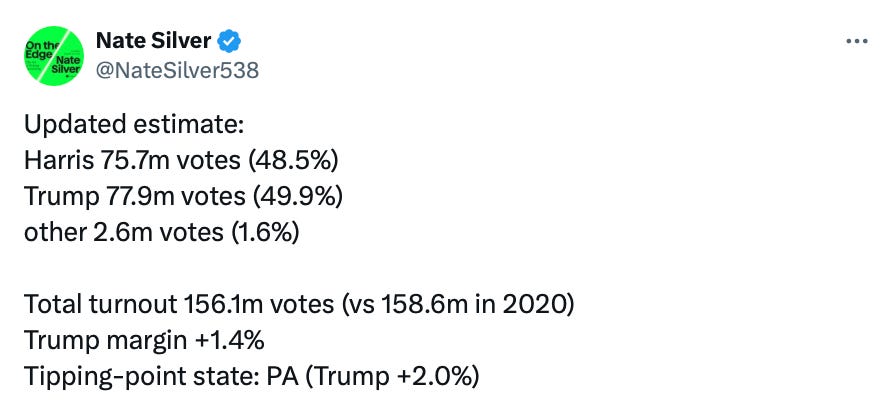
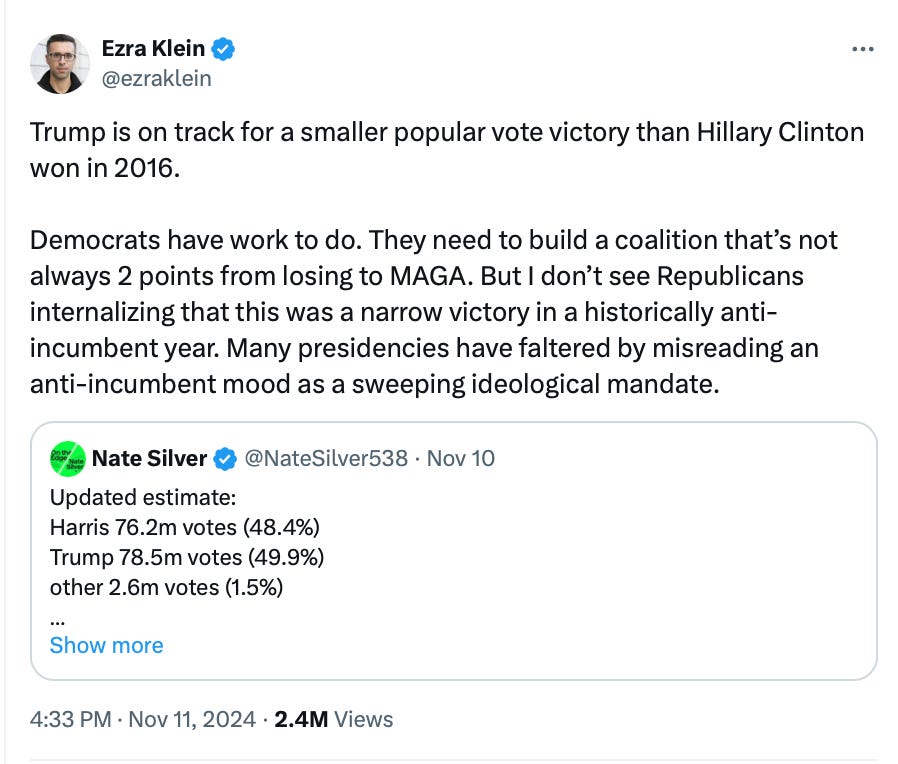


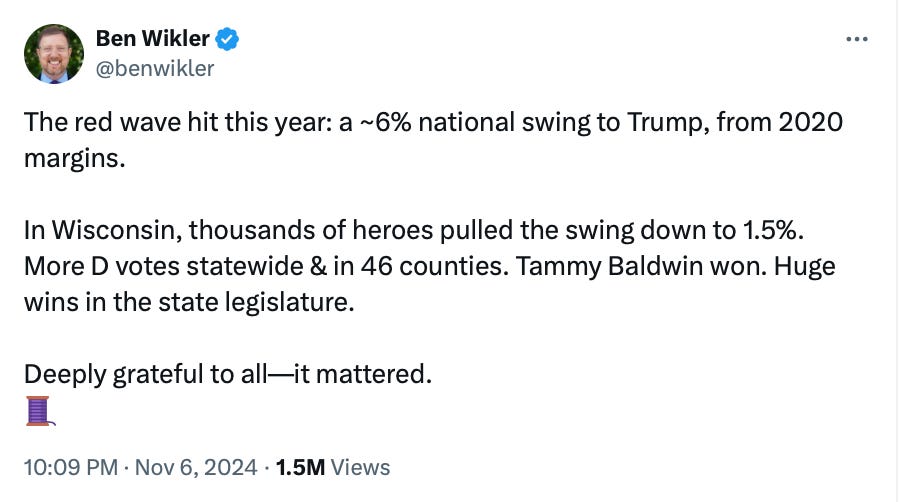
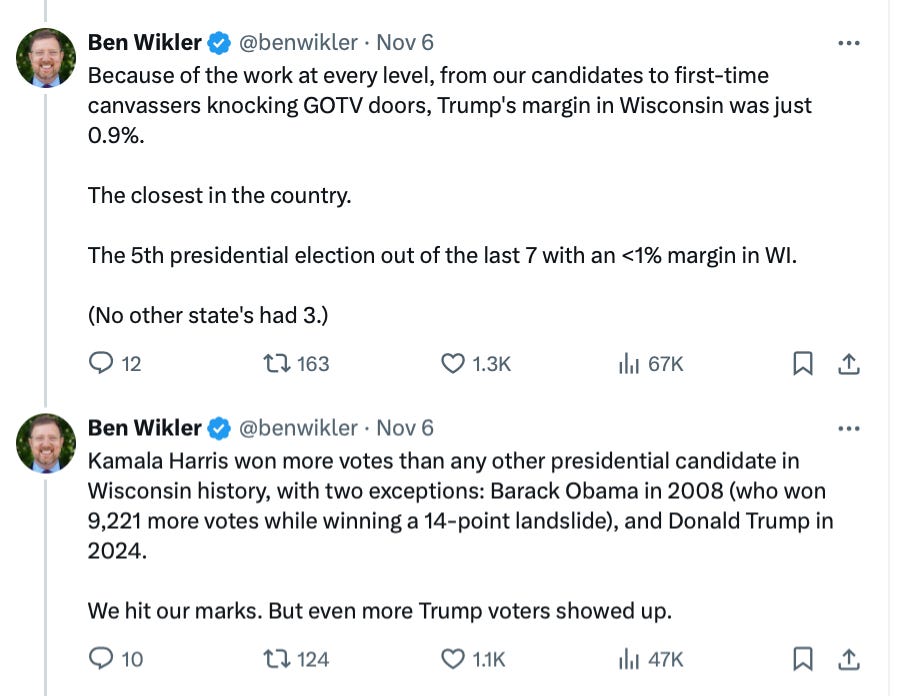

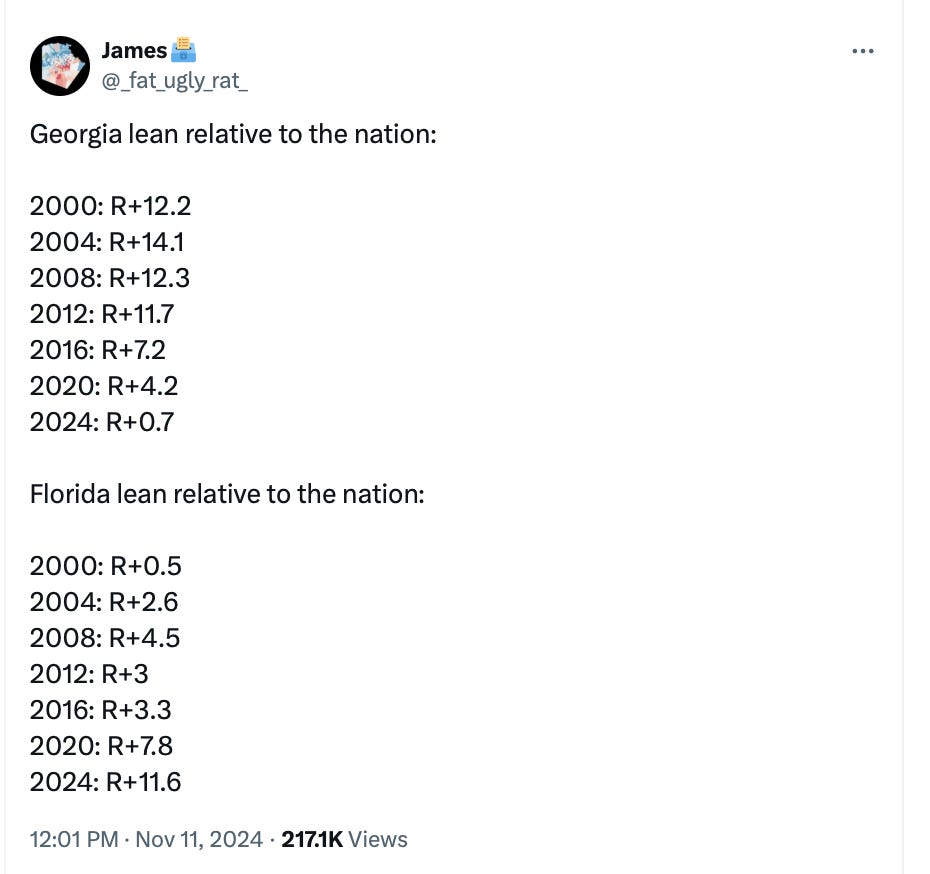

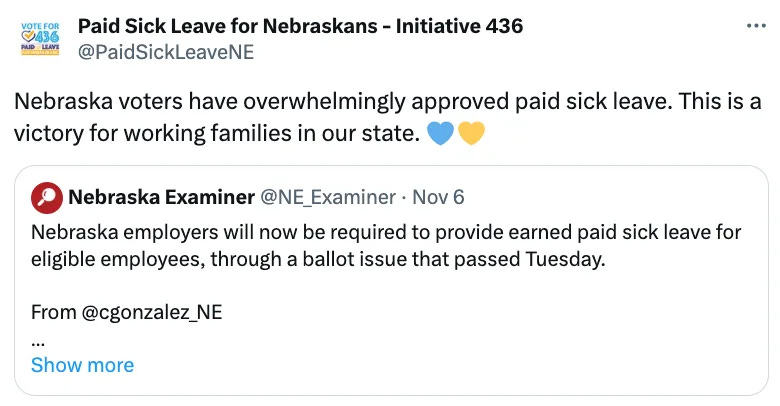













All of your points are well taken, but much of the "resistance" assumes that the Constitution will be honored - in particular, that the courts will operate independently and that federal officials will abide by their orders. It also assume that the GOP will not narrow or throw out the Senate filibuster. And it assumes no invocation of martial law because of some sort of terrorist activity (real or contrived). There are reasons for hope but there are also reasons for vigilance and, if necessary, rapid response.
Worst aspect of the Dems' morning-after laments has been the vilification of the trans community, and just appalling scapegoating of a tiny, vulnerable minority as SOMEHOW costing Harris votes in the swing states. Shameful, cowardly piling-on behavior.